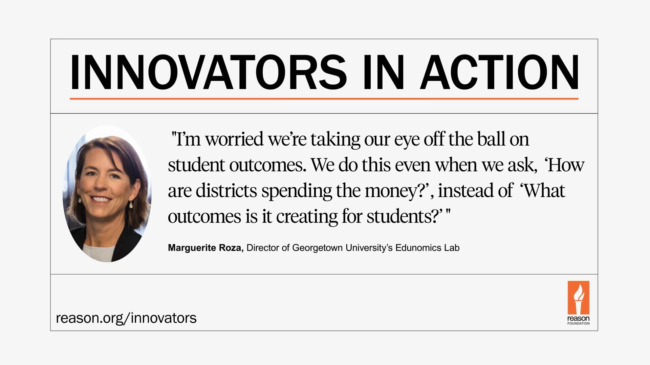During the first year of the pandemic, Congress funneled $204 billion in emergency K-12 education dollars to the states through the CARES act, CRRSA acts, and ARP spending measures. This sum is more than double the amount spent on K-12 education by the Obama administration’s American Recovery and Reinvestment Act of 2009.
Marguerite Roza, the director of Georgetown University’s Edunomics Lab, has followed how and where school districts are deploying their emergency funds. While she commends the speedy distribution of emergency funds and many districts’ efforts to meet the constantly changing context, she urges leaders to stay laser-focused on the emergency funds’ true purpose: ameliorating learning loss and getting kids back on track. Our conversation has been condensed and edited for clarity.
Schwalbach: What challenges do school districts face while spending the emergency funds distributed since the onset of the pandemic?
Roza: We’re asking a lot of districts right now. In most districts, student learning took a seismic hit. The federal government did hand out big public money to spend—and fast—but with that came a massive workload for leaders who must quickly draft plans and launch programs amid ever-changing demands of the moment. We’ve seen some promising examples of districts responding quickly and being nimble with their funds, from the Atlanta district lengthening the school day by 30 minutes and paying $3,000 to each teacher to do so, to the DeSoto, Texas, district where they’re targeting $5,000 signing bonuses for teachers in high-need areas like science and special education. In another example, the district in Philadelphia acted rapidly to offer parents $300 a month to get their own kids to school in the wake of a bus driver shortage. But moving fast to stand up new offerings is tough work for districts and some seem to be bypassing hoped-for investments like adding learning time in part because of the logistical hurdles involved.
Schwalbach: What was the greatest lost opportunity during the past two years?
Roza: I’m worried we’re taking our eye off the ball on student outcomes. We do this even when we ask, ‘How are districts spending the money?,’ instead of, ‘What outcomes is it creating for students? Are students making progress with reading? If so, how many? And which ones? And for high schoolers, how many kids have failed classes, and are we getting them back on track to graduate?’
My sense is that a better way to track the value of this big public investment is to track whether that spending is bringing about some measurable progress on students’ outcomes.
“I’m worried we’re taking our eye off the ball on student outcomes. We do this even when we ask, ‘How are districts spending the money?,’ instead of, ‘What outcomes is it creating for students?'”
Marguerite Roza
Schwalbach: Moving forward, what recommendations do you have for school districts?
Roza: Elsewhere we’ve urged school districts to be conscious of impending fiscal cliffs. By cliffs, I mean that most new investments will be eventually cut since their funding relies on temporary federal dollars. School districts might consider investments that lead to fewer disruptions when cut. For instance, tapping retirees for temporary work instead of hiring new staff who could then get laid off when the funding dries up. It’s very disruptive for staff, families, and organizations, both politically and socially, when staff are pink-slipped.
Another strategy to consider is pushing some decisions about relief spending down to schools. Districts can take some of their relief dollars, say, $500 per student, plus an extra $250 for each low-income student, and have school principals decide how to spend the money. School leaders could spend it on stipends: for staff working late, for incentives for parents to return their kids to in-person learning, or for kids in middle and high school to spend 20 minutes on Khan Academy. Such localized flexibility lets people jump in and help in this all-hand-on-deck moment.
And districts can do more to communicate with families so they’re aware of the investments and know what the goals are.
Schwalbach: In a recent Forbes article, you propose that districts consider making direct payments to families. How would this work and is anyone doing this?
Roza: I said before that this is an all-hands-on-deck moment. (I was in the Navy, so that phrase resonates with me). With many districts facing staffing shortages, this seems like a time when districts might tap parents to help with various challenges. A district could pay parents to ensure their child reads for 20 minutes each night or completes their math homework. While it goes against the grain of many districts to write checks to either kids or parents, we are seeing some districts try it out.
There are districts paying kids to get vaccinations or paying parents to transport their kids to school (to relieve pressure on transportation systems with less capacity right now).
It’s a strategy that more deliberately leverages parents as the school district’s partners. Parents care tremendously about their kids, and if we ask them to step up in small ways, many of them would do it.
Schwalbach: I’m curious, what are you hearing in response to this co-production idea?
Roza: The most common response we get is, “Are you sure we’re allowed to do that?” (Yes). And “Is that a voucher?” (No.) Direct payments aren’t vouchers since the funds are distributed by the district to families enrolled in the district. Funds don’t bypass the district as they would with a voucher. Rather, the district is choosing to use its own funds to get families to work in tandem with the district.
Another common question is “What are the mechanics? Do I have to collect IRS information on every parent who gets a payment?” The good news is that so long as the payment is less than $600 per pupil, school districts aren’t required to collect IRS information. To navigate this new field, districts could consider hiring an intermediary.
And districts worry that this mechanism won’t work for all families—which is true. (Take those who can’t ensure their kids are spending time reading at home or doing math homework in exchange for a stipend.) Districts would want to concentrate remaining funds on programs for those students who still aren’t making progress. That way, the district attacks the problem from all sides.
Schwalbach: Have any districts been especially successful at implementing a thoughtful recovery plan with relief dollars?
“More than anything, I hope that districts are measuring their own progress so they can know what’s working and what’s not.”
Marguerite Roza
Roza: It’s early, and most districts have only spent a portion of the money so far. Some districts, like those in Boston and Chicago, are delivering a share of their dollars to schools for more customized uses for their students. We’ve seen a lot of innovative pay and stipend activity targeted to addressing specific staffing shortages or other challenges. Places like Hawaii launched summer programs and Tennessee has a massive tutoring effort underway.
Of course, leaders need to stay flexible. We’re hearing some find that their plans to hire counselors turned up few qualified applicants; so, they need to pivot. Similarly, if a given plan doesn’t elicit positive student outcomes, the district needs to be able to shift quickly to a different approach and keep the focus on students.
More than anything, I hope that districts are measuring their own progress so they can know what’s working and what’s not. That’s what will keep the focus on getting students back on track. Imagine if a district set up systems to monitor early reading. Principals and teachers could adjust their efforts regularly to concentrate on those not making progress. Or consider a focused effort on student engagement that tracked whether counseling and other efforts were boosting on-time attendance, homework completion, and class participation.
We’ve got a lot of ground to cover to help schools and students reprioritize learning and get up to speed. This is a heavy lift for schools. But leaders now have dollars in hand (thanks to the federal investment) and need to pull out all the stops—including tapping their families—to ensure that it all happens, and soon. ESSER is a massive investment, and there’s a lot riding on these funds. Now it’s up to districts to ensure their kids benefit.

